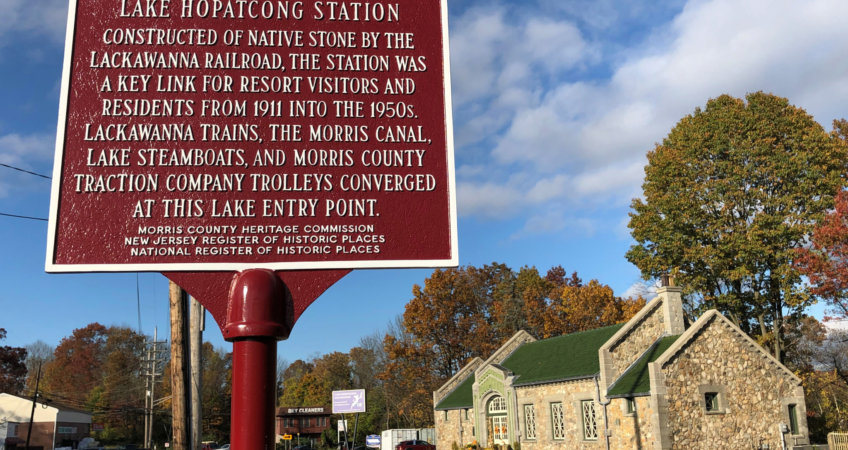Celebrating NJ’s 350th
Morris County has a rich history, and each of our 39 municipalities has an historical tidbit to contribute to it. Each town is named and is labeled with a tag: Innovation, Diversity or Patriotism. These tags were utilized when New Jersey celebrated its 350th anniversary in 2014.
- Boonton: Diversity: More than a century and a half ago, Boonton was an epicenter of anti-slavery work and considered one of the most important Underground Railroad links in the New Jersey chain that moved some 40,000 slaves north to freedom in Canada. It was home to local abolitionist Dr. John Grimes, who met with other anti-slavery activists here, published his monthly, the New Jersey Freeman, and sheltered runaway slaves in his home. It also was home Charles Fern Hopkins, a courageous Medal of Honor winning soldier who survived the horrors of the Confederate Army’s Andersonville prison. He helped his father, who owned the Powerville Hotel, harbor escaped slaves there, transported escaped slaves in his wagon and penned his Underground Railroad experiences in the 1910 publication Boonton: Gem of the Mountain, an account that identified individuals and communities that were part of the Underground Railroad’s operation in the Boonton area.
- Boonton Township: Innovation: Before aviation pioneer Lt. Jimmy Doolittle made his first official recorded “blind flight” on Long Island in 1929, he practiced here on a local airfield for a year. His trainer plane that made history was parked at Aircraft Radio Corp. hangar here. Doolittle relied on Aircraft Radio Corp.’s cutting-edge radio range receiver and gadgetry to make blind take-offs and landings possible on farmland transformed into an airfield with a 2,500-foot-long main runway. By 1933, the aviation corporation’s equipment was installed in the first Air Force and Navy fighter squadrons.
- Butler: Innovation: The story of Butler is written in rubber. The author was Richard Butler, who amassed a rubber manufacturing empire here, forming the Rubber Comb and Jewelry Company in 1876. The company later became the Butler Hard Rubber Company in 1882. Butler was president of the company and purchased more than 70 acres of farmland for residential development for his workers. Ultimately, when the borough was incorporated in 1901, Butler agreed to have the municipality named after him. While that alone is an impressive legacy, Butler was a founder and trustee of the Metropolitan Museum of Art and, from 1877 to 1902, was a member of the American Committee for the Statue of Liberty, serving as secretary and vital fundraiser for the construction and completion of the statue’s pedestal. He died in 1902 and by the 1980s the last of the rubber operations closed.
- Chatham Borough: Patriotism: How did Gen. George Washington fool the British to believe he was going to attack the Redcoats in New York in August 1781? He baked bread. Some 3,000 loaves a day in a 65-foot-long shed he ordered his troops to build to house the multiple brick oven operation on land that’s now Shepard Kollock Park in Chatham. Washington, who stayed in Chatham for three days that month, sent three regiments to guard and help the bakery staff, giving the appearance of an imminent attack. Instead, Washington and between 2,000 to 3,000 troops made way to Yorktown, Virginia, where the Continental Army defeated General Cornwallis in October 1781. Meanwhile, Shepard Kollock, a first lieutenant, served as the Continental Army’s chief propagandist, publishing the first copy of the New Jersey Journal in Chatham during the war.
- Chatham Township: Innovation: Located in Chatham Township and adjacent Long Hill, Harding, and into Somerset County, the 7,768 acre Great Swamp National Wildlife Refuge was the first wilderness area to be established by the Department of the Interior in 1964. Now there are 560. Here, natural resources are conserved and threatened, and endangered species and their habitats are protected. The refuge has become an important resting and feeding area for more than 244 species of birds. Fox, deer, muskrat, turtles, fish, frogs and a wide variety of wildflowers and plants can be found on the refuge. It took a four-year battle to create the refuge, rescuing the landscape from a proposed international jetport in the swamp, with four 10,000-foot runways that would have filled in the swamp and reduced hundreds of homes to rubble.
- Chester Borough: Innovation: Who invented the curveball? In Chester, the answer is Billy Dee, who lived here at 71 East Main Street. He had been the postmaster, a shopkeeper, and a Morris County freeholder from 1913 to 1916. He is best remembered, however, for his ball-playing. He is reported by the Newark News newspaper in 1881 to have pitched the very first curveball in the history of baseball when his finger caught in the covering of the ball. The Baseball Hall of Fame names William Arthur “Candy” Cummings of the Boston Excelsiors. Baseball lore also includes a competing claim of Fred Goldsmith of the Cincinnati Reds.
- Chester Township: Innovation: Martha Brookes Hutcheson was one of the first American female landscape architects in the U.S. She lived here on 100 acres which she and her husband named Merchiston Farm. She transformed the property into an oasis with a five-acre garden that included a reflecting pool, waterfalls and collections of colorful flowers. She had a distinct style, incorporating native plants in all of her designs and, in 1923, she published The Spirit of the Garden, a book about gardens she designed to showcase her principles of landscape architecture. Merchiston Farm remained her home until her death in 1959. The property was donated to the Morris County Park Commission in 1972. The gardens were placed on the State and National Registers of Historic Places in 1989.
- Denville: Patriotism: This was home to the noteworthy William Winds, who was a Continental Army colonel and brigadier general of the militia during the Revolutionary War. In 1765, he was a justice of the peace, working for the king, when the British Parliament imposed a tax colonists would have to pay to use legal papers and newspapers, among other things, printed on stamped paper produced in London. Winds scoffed at that idea, swapping the bark of the white birch for the stamped paper. In 1776, he represented Morris County in the General Assembly and was a delegate to the Provincial Congress that assembled in New Brunswick in 1776. He is also known for arresting the Governor of New Jersey, William Franklin, the last of the royal governors.
- Dover: Innovation: Dover, an entertainment destination that drew the likes of Grover Cleveland, Mark Twain, Thomas Edison, and Babe Ruth, had one of the most renowned playhouses in New Jersey once upon a time — the Baker Theater. Opening its doors in 1906, the 1,146-seat premier venue was built by mining mogul William H. Baker for $75,000, which is equivalent to a price tag of about $1.9 million today. The Baker housed picture shows which were shown at 7 p.m. followed by five acts of vaudeville at 8 p.m. A seven-piece orchestra played for both the picture and stage shows. It was a draw for many stage and screen actors, including DeWolfe Hopper, Helen Hayes, Lillian Russell, Ethel Barrymore, Lou Costello, Joe Cook, George Burns and Gracie Allen, and Harry Houdini. It underwent extensive remodeling, various facelifts, and changed hands over the years. It is still in operation. Dover Guide and Walking Tour
- East Hanover: Patriotism: As pastor of Presbyterian Church here on Mount Pleasant Avenue from 1746 to 1790, the Rev. Jacob Green was one of the most highly regarded voices for the American Revolution. He generated public support for independence from the pulpit and his sermons were well known as were his pleas for the abolition of slavery. Green served as a Morris County representative to the Provincial Congress of New Jersey in May 1776. While there, he served on the constitutional committee that drafted the Constitution of New Jersey that was adopted on July 2, 1776. The current church was built in 1834, replacing Green’s church built in 1755.
- Florham Park: Innovation: It was called Eisenhower grease and it was developed by an inventor named Arnold “Red” Morway at Exxon Research and Engineering here in Florham Park. What it did was waterproof motor equipment of military tanks and trucks and other vehicles during World War II, something critically important in the speed of amphibious Allied invasions in France, such as the legendary D-Day invasion in Normandy. It was also used by Lt. General George Patton’s forces in Sicily and campaigns in the Pacific.
- Hanover Township: Innovation: The first television broadcast took shape in the Whippany section of Hanover Township on April 7, 1927. On that day, then Secretary of Commerce Herbert Hoover spoke over the telephone in Washington and was seen and heard in the Bell Telephone Laboratories in New York. Then a radio program was broadcast over the laboratories’ experimental station in Whippany. The moving images of performers, as well as the sound of their voices, aired and were transferred to a television screen in New York City. The first demonstrated telecasts showed television’s great potential.
- Harding Township: Patriotism: Four miles south of Morristown there’s historically sacred ground where more than 10,000 of Gen. George Washington’s soldiers during the Revolutionary War weathered one of the most brutal, blizzard-packed winters on record. Located in Harding and Morris Township, Jockey Hollow was a log-hut city, serving as the site of the second winter encampment in the Morristown area for Washington and his Continental Army in 1779-80. While he stayed warm at the Ford Mansion in town during the seven-month stay, it was a little less cozy for his troops, who cleared 900 acres to build 1,000 to 1,200 huts – most of them about 14 feet by 16 feet, with a dozen soldiers in each cabin. The infantry brigades were from Maryland, Connecticut, New York, Pennsylvania, New Jersey, and Rhode Island. Jockey Hollow is part of the Morristown National Historical Park (NPS).
- Jefferson Township: Innovation: Nearly a century ago, the circus came to town. Alfred T. Ringling of the famous Ringling brothers — think “Greatest Show on Earth Ringling Brothers, Barnum and Bailey Circus” — hunkered down here during the winters 1916 through 1919. And it literally came to town, with a procession of big cats, elephants, and animals from the Oak Ridge train station to his 1,000-acre estate off Berkshire Valley Road. The estate is listed on the State and National Registers of Historic Places. Besides the stone and poured-concrete manor home with more than two dozen rooms, the estate included a music room, theater and structures that housed lions, elephants, monkeys, birds, horses and other animals. Circus performers auditioned there, as did stars from the screen and stage. After Ringling died in 1919, his widow sold the estate for residential development. Some of the remaining animal houses were incorporated into a public golf course.
- Kinnelon: Patriotism: One of the significant furnaces and iron mining operations during the Revolutionary War was the Long Pond Iron Works here. It was deemed so important, Robert Erskine, George Washington’s key surveyor and map maker, posted his own militia there. This was the first organized militia in New Jersey. Its duty was to protect furnaces against raiding British soldiers.
- Lincoln Park: Patriotism: Another important Revolutionary War tavern with a historic link to George Washington-John Dods Tavern, built circa 1770. It still stands and is listed on the State and National Registers of Historic Places. Washington’s officers wrote to the general about the tavern along the route connecting West Point to Morristown, and his soldiers bought food and drink there. There has even been some written speculation that Washington stopped in.
- Long Hill Township: Diversity: It was a magnet for a diverse skilled workforce in 1897, the Stirling Silk Mill Manufacturing Co., attracting immigrants from Italy, Poland, Switzerland, France and Syrians from Armenia, joining the Irish, German, English and Dutch newcomers of the 1700s. At the time there were close to 85 buildings operating at the site. More workers triggered more housing, changing the face of the township. The U.S. Hammered Piston Ring Corp. moved into the old buildings between 1938-39 and later this was home to General Air Products Co. which was destroyed by fire. None of the buildings now stand.
- Madison: Innovation: An influx of millionaires from New York City moving into their newly built country estates here and nearby in the mid-1880s had it right: What better way to brighten up your mansion than with fresh flowers? That daily demand sparked the growth of individual greenhouses and hothouses. Just before the turn of the last century, Madison was internationally known for its roses, with many new varieties and rose shows. Each year, many millions of cut roses were sent to NYC. By 1896, there were 45 growers in business with 200 employees in Madison, which was aptly nicknamed “The Rose City.” While the last of the greenhouses ceased operation in mid-1980, the rose growing history remains part of the local identity, with the nickname part of the town’s logo and website-www.rosenet.org.
- Mendham Borough: Patriotism: As a Revolutionary War captain in charge of the local Minutemen militia, David Thompson wasn’t popular with the local Tories loyal to the king. Neither was Thompson’s wife Hannah, or so the story goes. According to local lore, she didn’t take kindly to an old Tory who liked to stop by and give her husband grief for siding with the rebels. On what was perhaps his last visit to the Thompson house, he turned his tirade on the missus, who was home alone. She doused him with a bucket of hot water. The West Main Street house built in 1765 was a warm safe haven for starving soldiers struggling to survive in Jockey Hollow during the harsh winter of 1779. Thompson helped raise men, money, and arms for the cause, and served as a judge of the Court of Common Pleas of Morris County from 1778 to 1799. He died in 1824. The house is still standing.
- Mendham Township: Innovation: It was called Jersey Lightening. A distilled intoxicating concoction named applejack and commonly known as apple whiskey. The hooch made Mendham Township famous and of the many cider mills cranking it out between the early 19th century and Prohibition, Thomas Laughlin’s water-powered cider mill on Mendham Road was the most legendary. The three-story rubble- stone Nesbitt mill opened as a grist mill in 1848, was converted to a cider mill in 1908, and closed in the 1930s thanks to the Prohibition. It is now fully functional and operates as a museum.
- Mine Hill: Patriotism & Innovation: The Dickerson Mine was one of the oldest and most renowned mines in New Jersey. The first iron mine registered in the state in 1713, it supplied much of the iron ore used during the American Revolutionary War and played a major role in the thriving local iron industry for some 200 years. After the Dickerson family acquired the mine, Mahlon Dickerson became its most famous owner and local resident, serving as the 12th governor of New Jersey in 1815-1817, and later serving as U.S. Secretary of the Navy until 1838. The mine was part of Randolph until Mine Hill separated from Randolph in 1923.
- Montville: Patriotism: Gen. George Washington stayed in the Dutch stone Henry Doremus House on Main Road in June 1780 in between fighting with the Redcoats in Springfield. Alexander Hamilton joined him. At the time, he and his soldiers were protecting a shipment of war supplies being carted to West Point. The Colonial Army and French allies under General Rochambeau camped on the property in August 1781 while heading to Yorktown.
- Morris Township: Innovation: This was the location of New Jersey’s first mint, operating in 1786 through 1788 on the property long known as Wheatsheaf Farms, but originally named “Solitude,” where a skilled British machinist named Walter Mould was making money. The owner of the property was John Cleves Symmes, a member of the State Supreme Court and the father of the wife of U.S. President William Henry Harrison. Silver and copper were mined here and later became coins called penze, or horsehead pennies, with a shield and the Latin words “E PLURIBUS UNUM” on one side and a horse head, the year and the words “NOVA CAESAREA” on the other side.
- Morristown: Patriotism: George Washington put Morristown on the map in January 1777, when he and 3,000 troops marched into the then-village of 250 people and made it his winter headquarters. He stayed in Jacob Arnold’s tavern while his troops stayed in villagers’ homes and barns. He returned to Morristown for the winter of 1779-80 with 13,000 soldiers, who survived a brutal winter in huts in Jockey Hollow while Washington stayed at the Ford Mansion in town. Both sites are part of the Morristown National Historical Park (NPS).
- Morris Plains: Innovation: Homer C. Davenport, one of the most influential and highly paid political cartoonists of his time, is credited with establishing the flag-festooned Uncle Sam as the enduring personification of America. He called Morris Plains home. His home, “Red Gables,” was located on 27 acres on Tabor Road, where he entertained the likes of Thomas Edison and Buffalo Bill Cody and kept his stable of renowned Arabian horses. Davenport worked for William Randolph Hearst and helped elevate the might of the political cartoon. His most famous work – Uncle Sam tapping then-underdog presidential candidate Teddy Roosevelt for the White House with the caption, “He’s good enough for me.” – has been called the greatest vote-generating cartoon, helping Roosevelt win.
- Mount Arlington: Innovation: In 1885, a group of visionary business, civic and railroad leaders stood on the east shore of Lake Hopatcong, wondering what it would take to transform the untouched land into a fairytale-like getaway. The result was the magical Hotel Breslin, now considered the most pivotal trigger for the area’s growth as a resort destination. It opened its doors in 1887. The four-story 300-room hotel 185 feet above the lake dominated the landscape with its stained-glass windows, yellow exterior, and red roof. It attracted millionaires, summer mansions and celebrities. It was the first development on Lake Hopatcong with electricity. It closed during World War II and ultimately was destroyed by fire in 1948.
- Mount Olive: Innovation: Salmonella Disease got its name from an innovative scientist born here in 1850. Daniel Elmer Salmon went to the district’s school and was both a member of Cornell University’s first graduating class in 1868, and received Cornell’s first doctor of veterinary medicine degree. He also was the first director of the U.S. Department of Agriculture’s Bureau of Animal Industry and president of the American Veterinary Medical Association and American Public Health Association. In 1885, Salmon was the administrator of the USDA research program that isolated and identified the type bacterium that would be named after him.
- Mountain Lakes: Innovation: In 1910, a few families lived in this rural woodland setting, but ten years later, it was transformed into a planned garden suburban community featuring the work of one developer, Herbert J. Hapgood. Largely influenced by the Gustav Stickley and the American Arts and Crafts movement, many of his 454 original homes are still standing. Much of the town is listed on the State and National Registers of Historic Places and has the distinction of being the best-preserved collection of Craftsman-style homes in the country. The original residents came from New York City for the clean air and lakes, and used the railroad to commute to jobs in the city.
- Netcong: Diversity: In 1893 some Italian immigrants left their hometown of Cesa, a province of Caserta, Italy, to come to the United States. They settled in Netcong, attracted by job opportunities at the Singer Steel Foundry, and in the construction of the railroad which was replacing the Morris Canal as a means of transportation. Today, Netcong’s motto “All Roads Lead to Netcong” refers to the confluence of numerous roads including U.S. 80, 46, 202 and 183 which enter or abut the town. The Netcong train station is a terminus for a rail line that runs to Hoboken.
- Parsippany: Innovation: Gustav Stickley was an icon of the American Arts and Crafts Movement and is known for his famed furniture. Parsippany was his home in the early part of the last century. It is known today as The Stickley Museum at Craftsman Farms. Stickley’s chestnut log cabin country estate is now a national landmark and public museum. Stickley bought the property in 1908, planning on creating a boys crafts school. But when the school plans fizzled, Stickley and his family moved in, living there from 1910 to 1917.
- Pequannock: Patriotism & Diversity: The ironworks once located here north of the falls, above what is today the Hamburg Turnpike, was a bustling forge operation with a diverse workforce. English, Belgian, Scottish and German workers were imported to work in the mines. Plenty who planted roots here tied the knot with the Dutch, Native Americans and African-Americans living here. In 1777, the forge supplied 7,000 cannonballs each up to 18 pounds to General Henry Knox for the war. Ultimately, the ironworks changed hands and stopped operating in 1907.
- Randolph: Diversity: The Randolph Quaker Meeting House, built in 1758, is the oldest existing house of worship in Morris County and its members were at the forefront of the anti-slavery movement. One member freed his slaves in 1776 and two members, Hartshorn Fitz Randolph and Isaac Hance, were among the founders of the first anti-slavery society of New Jersey. In 1839 the greatest of the Randolph Quaker abolitionists, Jacob Lundy Brotherton, helped found the New Jersey State Anti-Slavery Society. The house was added to the State and National Registers of Historic Places in 1973.
- Riverdale: Innovation: Slater’s Mill traces its roots to the early 1700s, when a grist mill operated on the property. Five years after a fire destroyed the mill, and a new one was built, Joseph Slater bought it in 1849 and converted the operation into a felt factory. After his death in 1871, his son, Robert, took over and expanded the business, employing 16 workers who produced a steady supply of hatters’ furs. A major buyer was the famous J.B.Stetson. With large crowns, wide brims and Old West flair, the hats were worn by the likes of the first Lone Ranger, Clayton Moore, country singer Gene Autry and John Wayne. Fueled by water, the mill lost its source of power in 1903 when a dam at the mill’s pond was destroyed by a flood. The long vacant mill is on the State and National Registers of Historic Places.
- Rockaway Borough: Patriotism: All U.S. Presidents have bodyguards. George Washington had Captain Steven Jackson, who lived here. While a historic marker identifying the location of the Stephen Jackson House at 40 Main St. notes Jackson provided the general with refreshments in 1780, it’s believed Washington, while inspecting nearby mining operations, likely stayed in Jackson’s home for a couple of days. The original eighteenth-century wing was removed in 1867, but the 1816 Federal-style wing remains.
- Rockaway Township: Patriotism: Call him one of the most famous arms dealers of the 18th century. He was John Jacob Faesch and his home here still stands. The 12-room Ford-Faesch Manor was built between 1768 and 1770 by Jacob Ford Jr., whose Morristown mansion served as Gen. George Washington’s winter headquarters in 1779. Swiss mining engineer and ironmaster John Jacob Faesch lived here while overseeing a massive furnace operation that served as the biggest supplier of ammunition for Washington’s troops. Washington stayed here too.
- Roxbury: Patriotism: Here is the location of the former gunpowder, dynamite and ammunitions plant that helped the United States military win two world wars. Originally opening in 1871 to provide dynamite to iron mining operations, Hercules Inc., based in Delaware, at one time employed 6,000 at its 1,200-acre Roxbury site. The company was responsible for developing the first bazooka rocket propellant. After two explosions in 1934 killed six workers, powerful blasts triggered by the explosion of 297,000 pounds of gunpowder in 1940 rocked the entire area, leveling nearby buildings, shattering windows for miles and sending shaking, bouncing cars off the road. When the dust settled, 51 workers were dead and more than 200 people were injured. The plant closed in 1996.
- Victory Gardens: Patriotism: Victory Gardens was a product of patriotism six months after the bombing of Pearl Harbor in 1941. It was named for the Victory gardens planted at homes during World War II and its streets are named after U.S. Presidents. Ramping up wartime production, the federal government created a 300-unit housing project for workers mostly at Picatinny Arsenal on 91 acres of Randolph Township. Victory Gardens was incorporated as a borough 10 years later.
- Washington Twp.: Innovation: There was treasure in Schooley’s Mountain here, but it wasn’t gold. It was pure chalybeate mineral water known for its healing powers, better known as the famous Schooley’s Mountain Spring. After it was discovered in the last half of the 1700s, a slow transformation into a mountain health retreat followed. In the 1800s luxurious hotels were built with access to the spring’s outlet nearly a mile down the mountain. Guests included the Vanderbilts and Roosevelts, Thomas Edison and U.S. Presidents Ulysses S. Grant and Benjamin Harrison.
- Wharton: Diversity: The booming iron ore mining industry was a magnet for immigrants from Western and Central Europe in the 19th and 20th centuries. The transformation was triggered by mining supervisor Robert E. Oram, whose business savvy turned the area with scattered mines into a bustling port along the Morris Canal and train depot on the Morris and Essex Railroad line. That attracted an influx of Irish, Scotch, English, German, Russian, Polish, Czech, Welsh and Hungarian newcomers.






